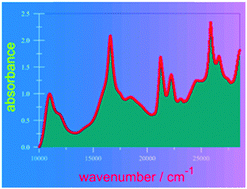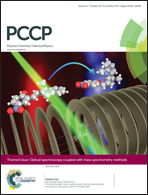A bifurcated molecular pentad capable of sequential electronic energy transfer and intramolecular charge transfer†
Abstract
An extended molecular array, comprising three distinct types of chromophores and two additional redox-active subunits, that harvests photons over most of the visible spectral range has been synthesized and characterised. The array exhibits a rich variety of electrochemical waves when examined by cyclic voltammetry but assignment can be made on the basis of control compounds and molecular orbital calculations. Stepwise electronic energy transfer occurs along the molecular axis, corresponding to a gradient of excitation energies, to populate the lowest-energy excited state of the ultimate acceptor. The latter species, which absorbs and emits in the far-red region, enters into light-induced charge transfer with a terminal amine group. The array is relatively stable under illumination with white light but degrades slowly via a series of well-defined steps, the first of which is autocatalytic. One of the main attributes of this system is the capability to harvest an unusually high fraction of sunlight while providing protection against exposure to UV light.


 Please wait while we load your content...
Please wait while we load your content...